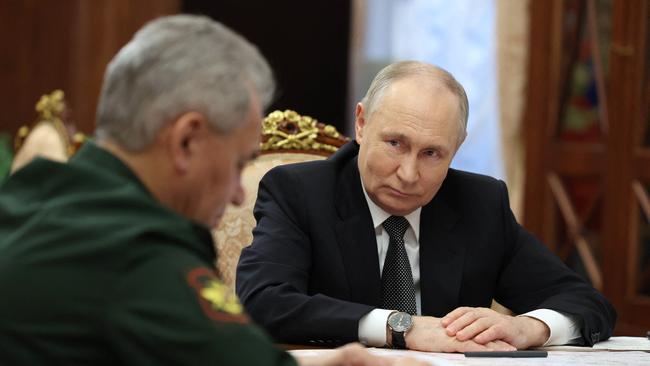Ukraine cannot win without a bigger army
Western arms and money are vital but it will take more manpower to resist a revived Russia.

Remember the days in 2022 when it was in vogue to sneer at the invading Russian army in Ukraine? When memes mocked the stupidity of Russian commanders sending their doomed men to die in droves, or trumpeted their deaths in blazing armoured columns, as if death were a foolhardy venture for Russians, a folly that would in future deter them?
There were plenty of causes for dark glee in that first year following the Russian invasion of February 24. Ukraine’s ferocious defence against the invader suggested that the impossible might just be possible. By spring the Russian assault on Kyiv was thwarted, in early autumn swathes of territory were recaptured by Ukrainian troops east of Kharkiv, and by November Kherson was liberated.
Those were days of giddy speculation in the western press, in which musings over Russia’s defeat in Ukraine were bandied around as if it were already a fait accompli. British Ministry of Defence officials, forgetful of Russian will, fanned the froth in background briefings, suggesting that Ukraine might be triumphant within a year.

How far away those days seem now. This week, the second anniversary of the Russian invasion, finds Ukraine in a far more perilous state than a year ago. A string of bitter Ukrainian defeats - including Bakhmut, the thwarted summer counter-offensive, and the capture by Russian troops last week of Avdiivka - litters the past 12 months and Kyiv has entered 2024 beset by uncertainty over the fealty of its western allies, while its Russian foe has regenerated and transformed.
Ukrainian setbacks in the past few weeks alone look grim: the dollars 60 billion package of US support earmarked for Kyiv still faces an uphill struggle in the House of Representatives; President Zelensky fired the widely admired commander of Ukraine’s army, General Zaluzhny, and replaced him with the austere General Syrskyi; Russian offensives were mounted on five different sectors of the front; and Alexei Navalny, Putin’s most prominent critic, lost his life in a gulag.
These gathering adversities don’t guarantee Ukraine’s defeat this year. If the challenges it faces are quickly addressed, Kyiv might still fight its way to an advantageous negotiated settlement which, if it included membership of the EU and Nato, would clearly be victory.
However, as the invasion enters its third year and the struggle has become characterised by attrition rather than manoeuvre, the battlefield advantage in 2024 has swung clearly in Russia’s favour. Ukraine faces three key sets of challenges that must be met if it is to regain the initiative.

Foremost, the vacillating will of its western allies is already having a direct impact on the eastern battlefields. Apart from the effects of a potential Trump win in November’s presidential elections, the delay in approving the latest tranche of US support to Ukraine has contributed to the loss of Avdiivka by depriving Ukraine of vital artillery munitions.
Despite its own rhetoric, support for Ukraine from the European Union has been similarly spasmodic. An EU commitment last year to supply Ukraine with a million artillery shells by March 2024 will fall badly short with little more than half that number delivered on time. Russian industry, meanwhile, bolstered by supplies from North Korea, has given the Kremlin’s forces a ten to one advantage in artillery fire on the front.
Aside from the vagaries of its allies, Ukraine is entangled in its own political and military problems too. Although a new mobilisation bill is under discussion, Zelensky has so far blanched at reducing the age of mobilisation from 27 to 18, leaving degraded Ukrainian combat units along the 600-mile front line - where fighting troops now have an average age of 43 - short of men, and exhausted by perpetual operations.
Although it has had asymmetric successes elsewhere in the conflict, most notably using sea drones against Russian warships in the Black Sea, the war in Ukraine is primarily one for territory and will be won or lost by men at arms. Unless its manpower problems are fast redressed, the shortfall in fresh troops will negate Ukraine’s victories at sea.

Conversely, Russia has dramatically regenerated its own military capabilities. Responding to its earlier catastrophic errors, and with 10 trillion roubles (pounds 85.7 billion) assigned for defence spending in this year’s budget, Russian military industrial output easily outstrips Ukraine’s western allies in the supply of shells and war machines. Russian drone and electronic warfare assets dominate those of Ukraine too. Furthermore, Moscow has recruited more than 300,000 volunteer troops over the past year, even as Ukraine struggles to man the trenches with mobilised men.
The current trajectory has triggered a sobering reassessment of Ukraine’s chances of victory. Most analysts agree that, while Russia has the advantage, no fulcrum moment has yet been reached. Russia’s revitalised strengths will be offset if western industry and technology chooses to throw its might behind Ukraine soon, and if Ukraine mobilises more men in time.
However, these are big “ifs”, just two of many unknowns along the path to a Ukrainian victory that might one day, in the best case, involve the retention of most of its rump territory, along with EU and Nato membership.
Amid this array of uncertainty, one thing is for sure: in 2024 no one is mocking the Russian army’s casual disregard of its soldiers’ lives. As Ukraine has learnt, killing them in droves is not enough to send them home.
THE TIMES



To join the conversation, please log in. Don't have an account? Register
Join the conversation, you are commenting as Logout